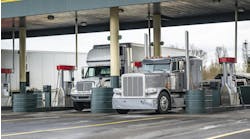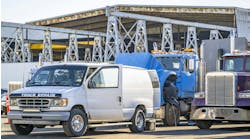Navigating the messy middle: Lithium battery systems for emissions and cost savings
The path to decarbonizing the trucking industry is complicated—and for many fleet operators, it’s a journey through what’s known as the "messy middle." Coined by the North American Council for Freight Efficiency, this term describes the current phase of the industry’s transition, where a mix of powertrain options—from advanced diesel and renewable fuels to battery-electric and hydrogen fuel cells—are vying for attention, but none offer a one-size-fits-all solution for every duty cycle.
The question for fleets is no longer if they will adopt cleaner technologies, but when and how they will do so. The challenge lies in choosing the right solutions for today while positioning operations for the future. But the “waiting game” is no longer a viable strategy. Fleets need to act now to remain competitive, cut costs, and reduce their carbon footprints.
While battery-electric trucks and hydrogen fuel cells are often seen as the ultimate decarbonization solutions, these technologies are not yet universally viable. For long-haul trucking, which is critical to moving goods across vast distances, full electrification remains limited by high costs, long charging times, and sparse infrastructure. Hydrogen fuel cells, while promising, also face similar obstacles in terms of refueling infrastructure and cost per mile.
So, what’s a fleet to do in the messy middle? The solution lies in leveraging existing technology that can be deployed today. Advanced lithium-ion battery systems, including all-electric auxiliary power units, offer a bridge to cleaner operations without waiting for infrastructure or full vehicle electrification to catch up.
"In the midst of trucking's transition to zero emissions, fleets can't afford to wait for the perfect solution. By integrating advanced lithium-based technologies like Dragonfly Energy’s all-electric APU today, fleets can make immediate strides toward reducing emissions and improving efficiency, all while preparing for the electrification of tomorrow," Jeff Seger, lead author of NACFE’s The Messy Middle report, said.
Not ready for full electrification? Start with lithium
The key to a successful strategy in this transitional period is a hybrid approach—one that combines the efficiency of advanced diesel or renewable fuels with the flexibility of lithium-based systems. While electric trucks may not be ready for every duty cycle, integrating lithium-based APUs into a fleet's operations can dramatically improve fuel efficiency, reduce emissions, and lower overall operational costs.
Lithium batteries, especially LiFePO4 (lithium iron phosphate), are perfectly suited to auxiliary applications such as powering cab comfort systems and hotel loads during rest periods or even liftgate operations. These all-electric systems eliminate the need for idling, a practice that not only wastes fuel but also increases engine wear and emissions. By replacing traditional diesel-powered APUs with lithium-powered alternatives, fleets can realize immediate fuel savings, extend engine life, and contribute to sustainability efforts—all without waiting for full truck electrification.
See also: NACFE Run on Less sets sights on trucking’s ‘messy middle’
The benefits of lithium-based APUs
Lithium-based APUs offer fleets a clear path forward, even in the midst of the messy middle. These systems allow for efficient, zero-emission auxiliary power generation, even in extreme temperatures. In regions with harsh winters, this becomes even more crucial. Traditional diesel-powered APUs can strain both fuel consumption and engine performance in cold weather, whereas lithium systems maintain performance without requiring the engine to run. This technology keeps drivers comfortable, avoids unnecessary idling, and ensures critical systems—such as heating, cooling, and electrical loads—remain operational.
The advantages extend beyond just operational efficiency. With fleets facing increasing pressure to meet sustainability targets and regulatory mandates, lithium-based APUs contribute directly to reducing greenhouse gas emissions. These systems are far cleaner than traditional idling practices, helping fleets improve their environmental impact at a time when being “green” is no longer optional but required.
The road ahead: Making the most of hybrid solutions
The messy middle offers a window of opportunity for fleets to take incremental steps toward a zero-emissions future. Lithium battery systems offer a practical solution that doesn’t require a complete overhaul of operations. By integrating advanced battery systems into their fleets today, operators can begin the decarbonization journey without waiting for full electrification to become feasible. This hybrid strategy—incorporating both traditional powertrains and advanced batteries—allows fleets to reduce emissions, lower costs, and future-proof their operations.
In addition to APUs, lithium-ion batteries are also making waves in other auxiliary applications, such as powering electric vehicle charging stations, auxiliary loads for refrigeration units, and more. With continued innovation, these systems will only become more powerful, efficient, and widely applicable.
However, success in the messy middle requires more than just choosing the right battery technology. Fleets must also stay informed about evolving regulations, fuel prices, and infrastructure developments that will shape the future of transportation. The transition to zero emissions will require collaboration across the industry, including between manufacturers, fleet operators, and policymakers, to ensure the right infrastructure is in place to support these new technologies.
Infrastructure development: A critical factor
While lithium batteries and electric APUs represent a practical solution today, widespread adoption depends on the development of charging infrastructure. Fleets need reliable access to fast charging stations along key trucking routes. Fortunately, progress is being made, and both public and private sectors are investing in expanding this infrastructure. However, the pace of development needs to accelerate to keep up with the growing demand for electric solutions in the trucking industry.
In the meantime, fleets can make significant strides toward reducing their environmental impact by adopting lithium-powered APUs and other auxiliary power solutions. These technologies allow fleets to navigate the messy middle, achieving meaningful emissions reductions today while positioning themselves for the electric future that’s on the horizon.




